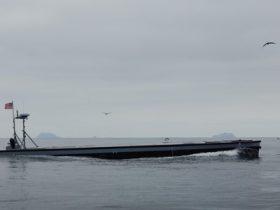PARIS — France kicked off the 2025 edition of its high-intensity naval exercise Polaris on Monday, moving the action to the Atlantic with a scenario including attacks against French naval ports, a multinational sea battle and amphibious operations on the English and French coasts.
Polaris 25 will run through June 15, deploying more than 3,000 French and foreign troops, more than 20 naval surface combatants and more than 40 aircraft, according to the defense ministry. The final stages will include naval combat between a task force of five amphibious helicopter carriers and their escorts opposing a peer adversary.
France’s first Polaris exercise in 2021 was held mainly in the Mediterranean, with the exercise part of a plan that year to step up the French Navy’s readiness for high-intensity warfare. This year’s edition will deploy fewer troops, in part due to the absence of the Charles de Gaulle aircraft carrier and its crew of about 1,200, but run for twice as long and with more international partners.
“The Polaris 25 exercise pits two symmetrical forces against each other in a free-play scenario, under conditions close to reality,” the Navy told Defense News in an emailed statement. “Polaris 25 is notable for its duration, with an initial phase dedicated to hybrid action in attack and defense, and for the scale of the resources deployed on the Atlantic coast.”
The exercise will include new training themes, in particular amphibious operations and the protection of naval bases and their approaches over time and in the face of a hybrid threat, and will evolve from initial contestation to confrontation, according to the sea service.
The French Navy has been boosting combat preparations in recent months with a live test of an explosive one-way drone boat, a firing of an F21 heavy torpedo against a decommission warship, and a shock test by detonating a sea mine near the Lafayette-class frigate Courbet as the vessel was under sail with its full crew.
Adm. Nicolas Vaujour, the French Navy commander since September 2023, has been seeking to harden the force and strengthen its immediate combat capability.
The first phase of Polaris 25 will run until May 26, involving only French units, according to the Navy. This part of the exercise will focus on defending French naval bases against hybrid attacks which could include commando actions or drone attacks, the Navy said.
While the Navy declined to provide specific details of the scenario, citing the need for surprise to keep the exercise realistic, a presentation document for Polaris 25 indicated initial action will target the naval ports of Brest and Cherbourg, with assets including cyber, drones and sea mines.
The second stage of the exercise will start with building up an international task force in the western Atlantic, with amphibious vessels from France, the United Kingdom, Spain and Italy carrying a French Army battalion, helicopters as well as British, Spanish, Italian and Brazilian troops. The amphibious group will be escorted by French, Spanish and Dutch frigates, and British patrol boats.
Air assets will be mainly French, and may include Navy-version Rafale jets and Airbus refueling aircraft, according to the Navy.
The blue force will perform an amphibious operation on the coast of Devon in south-west England between June 1 and 6, according to the presentation document. That will be followed by a five-day period of naval combat with the opposing red force of French, Italian and Dutch frigates as well as French Navy aircraft.
French nuclear attack submarines may be integrated into one or both forces, and the composition of the opposing task forces may change, the Navy said.
The final step of the exercise starts on June 11 and will involve an amphibious operation on the Atlantic coasts, according to the presentation document.
A notice to airmen published by France’s civilian aviation authority on Polaris 25 indicates a traffic exclusion zone over the Bay of Biscay running from the Gironde estuary to Bayonne near France’s border with Spain. That suggests a possible landing along the long stretch of surf-battered sandy beaches there.
The Navy said the naval combat and landing operations will follow a “multi-environment, multi-domain” approach, integrating space, cyber and informational assets.
Polaris 25 will strengthen immediate combat capabilities by involving bases and ports in the exercise, and will help provide new thinking on dealing with technological and human disruption, according to the Navy. The exercise is also part of joint engagement with European and NATO allies to secure Europe, it said.
Rudy Ruitenberg is a Europe correspondent for Defense News. He started his career at Bloomberg News and has experience reporting on technology, commodity markets and politics.
Read the full article here








Leave a Reply